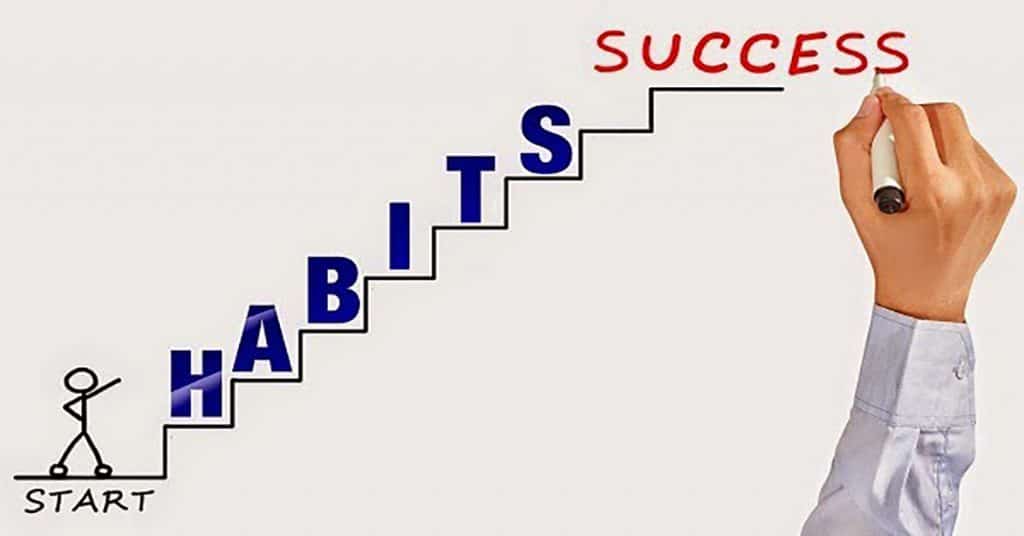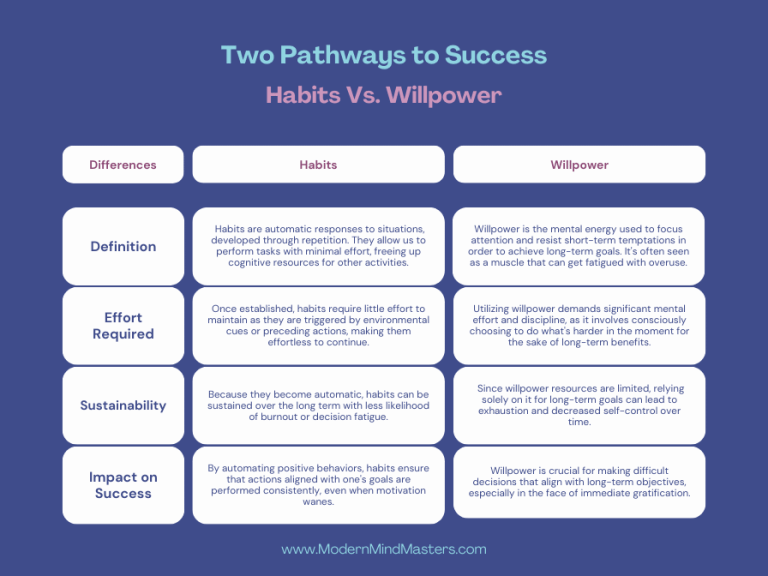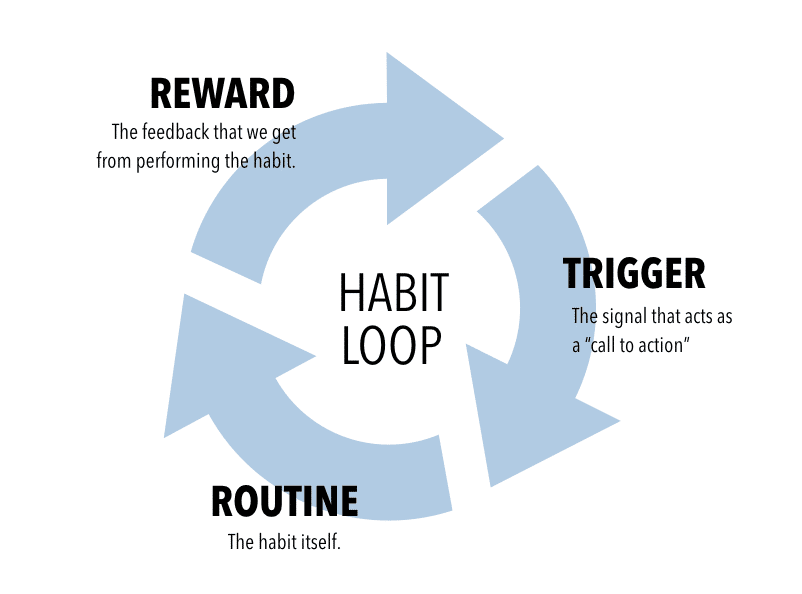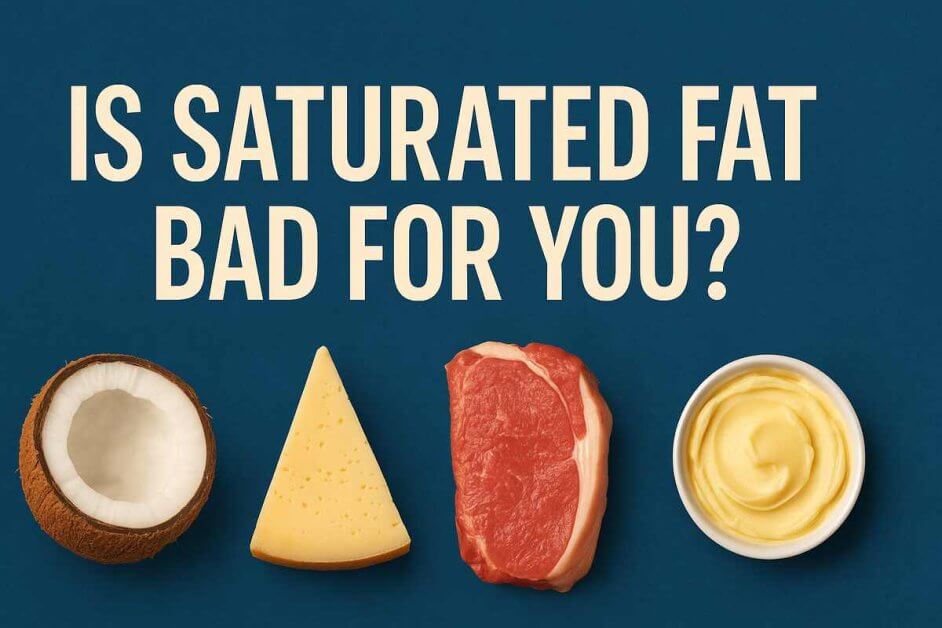
Goals and Habits – The Neuroscience of Behaviour Change
Goals are easy to set but often difficult to follow through with. Learn the neuroscience behind behavior change and how to use it to your advantage to set unbreakable goals.
Key Points:

From winning an Olympic gold medal to a startup business hitting its first $1 million in revenue, success is often glorified in a single defining moment. But these moments are just the resulting snapshot from decades of hard work preceding it; it is the years of behind-the-scenes habits that enable success.
Success, in the practical sense, is the result of small but productive daily habits compounded over time. Just as how the stock market will turn $45,000 into over $1 million over 45 years (at a 7% average interest rate), habits can lead to incredible feats of accomplishment when consistently applied over time.
Success is the result of small but productive habits compounded over time
Modern Mind Masters Tweet
On my 29th birthday, fearing age catching up on me, I set myself a series of goals that I had always wanted to accomplish before turning 30: learn the piano, learn Portuguese, write a book, and create this website you are reading now.
I am happy to say that as of April 2022, I had accomplished all of these. I did all this while working a 45-hour-a-week job.
I say this not to brag, but to demonstrate how habits can turn the seemingly impossible into the guaranteed. I did not achieve these because I am more intelligent or harder working than anyone else, I did it simply because I had learned the skill of creating sustainable habits.
We all have the same amount of time in a day, but how we utilize this time with habits determines how productive we can be. This article will explore everything you need to know to create sustainable habits that stick, one of the most fundamental skills that drive success.
Habits turn the seemingly impossible into the guaranteed.
Modern Mind Masters Tweet
Humans are, by nature, creatures of habit. This is good news for us – if habits are inherent then we just need to learn to leverage them. Evolution strives for efficiency to conserve energy. The brain does this by automating bodily functions and processes that are easy and repetitive, such as breathing and digestion.
In fact, around 45% of our reported tasks on any given day are perpetually performed without conscious input. If we had to think about every muscle we move and every breath we take, our entire day would be consumed just by living. Life would be pretty pointless!
Conscious decisions, ones in which we have to actively think about, such as first learning to operate a car, stem from the part of the brain called the prefrontal cortex. But the brain, with its drive for efficiency, shifts these repeatable actions to the basal ganglia, a different part of the brain where neuroscientists have traced automated habit-making behaviors to.
The basal ganglia, one of the oldest structures in our brain, is completely exempt from the process of thinking and acts as a biological autopilot to free up cognitive capacity for more pressing tasks. Ideally, we want to convert new habits we wish to commit to from the prefrontal cortex (the conscious mind) to the automated basal ganglia.
Once achieved, habits become easier to sustain as we don’t have to think about doing them, they become automatic.
So by building habits, we are utilizing the efficiency of human evolution to automate easily repeatable tasks, thereby freeing up more cognitive resources for more pressing conscious tasks. This is a double win – not only do we become more productive but we also reduce our need to rely on willpower to force our way through tough habits.
It is important to clarify that habits can be good or bad. On the one hand, they can lead us to accomplish impressive feats where willpower alone would almost certainly fail. But on the other hand, they can cause chronic procrastination and inefficiency, such as scrolling through social media every time you receive a message and pick up the phone.
Productivity, therefore, should not only focus on creating good habits but also on removing negative ones.
The most significant barrier to crafting good habits lies in misunderstanding the difference between habits and willpower. In fact, the topic is so important I have dedicated an article on the topic (click here).
In summary, willpower is a battle between the subconscious mind, which is driven by emotion and craves immediate gratification, and the logical conscious mind. Where the subconscious mind is impulsive and can only think in the present, we rely on the conscious mind to think into the future.
Often, we know we should delay immediate gratification (such as eating an entire cake now) because our future health is more important. The problem is the emotional subconscious mind is five times more powerful than the conscious, and often wins.
To overcome this power differential, we have to apply a significant amount of mental energy from our conscious mind to overcome the impulse for immediate gratification (e.g. procrastination). We can do this by using willpower, where we dig deep and use the motivation of thoughts of future success to access a large enough reserve of mental energy.
Willpower is extremely powerful, and hence extremely energy-intensive. And because it can be expended quicker than it can be recharged, it is therefore not a reliable source of energy.
This is why 95% of those attempting to quit smoking “cold-turkey” fail because the mental energy expended overcoming the need for instant gratification from their nicotine craving does not have time to recharge before the next craving.
Just a few days into their attempt to stop, they no longer have any remaining reserves of mental energy left to fight the cravings. The 5% who accomplish it, however, usually have greater motivation, and hence greater sources of energy, such as a recent health scare or thoughts of their dependent family members.
As willpower is unsustainable long-term, we need to instead utilize habits that transfer the subconscious emotional tasks to the automated basal ganglia, bypassing the emotional part of the brain and avoiding the need to use willpower altogether.
Although a certain amount of willpower is required to forge a habit, once it is created, the reliance on willpower is significantly reduced. Habits are reliable and sustainable, two key traits which are fundamental to success. Habits, therefore, make success a matter of when not if.

Habits make success a matter of when not if.
Modern Mind Masters Tweet
Now we understand what habits are, how they differ from but complement willpower, and why they are fundamental to success, let’s look at how we can build habits that last.
The habit loop, a helpful framework originating in “The Power of Habit” by Charles Duhigg, creates a three-step methodical process that turns habits into a simple and systematic process. The habit loop has three parts: triggers, behaviors, and rewards.

A trigger is an event that kicks off the automatic urge to complete a habit. They set the habit loop in motion by sending our brain into auto-pilot. An effective trigger must be specific, unavoidable, consistent, and automatic.
You can remember these as SUCA, which is what you will be if you try to create a trigger that doesn’t follow these terms. We will cover examples of effective triggers that you should aim to replicate shortly.
The second component, behaviors, are just the responses exhibited by the trigger. They are the actions or patterns of thought that make the habit.
Finally, rewards reinforce the habit by causing our brain to strengthen the associated link between the trigger and the behavior. Rewards can be anything, such as a sweet dessert for completing a tough workout, or a coffee having just completed your weekly report.
Perhaps it can even be the satisfaction of knowing you have completed it and don’t need to worry about it anymore. It just needs to be something that releases feelings of enjoyment and reward to close the habit loop, ideally tapping into dopamine and the dopaminergic system.
Triggers, behaviors, and rewards are the three points of leverage utilized when creating, strengthening, or eliminating habits. Habits can therefore be created, altered, or broken by focusing on our current habit bottleneck i.e. the “weakest link” of the three.
With each successful iteration of the cycle, the behavior becomes easier and the habit becomes stronger as the process is transferred to the automated basal ganglia.
Note the process for removing a bad habit is the same, but instead of creating a trigger, we must identify the trigger causing the bad habit and change it. For example, a common bad habit (one which I am frequently guilty of) is scrolling through social media after checking a phone notification.
If we wish to avoid procrastinating on phones, therefore, we need to identify that the notification is our negative trigger, and therefore avoid it (such as by putting your phone on “do not disturb”). But it is still important to reward the trigger and behavior in the same manner as creating a habit, such as allowing yourself 10 minutes to scroll through your phone once you have completed your task.
Whereas willpower can be called upon instantaneously, habits take time to develop. So to establish our habits effectively, we need to build up to our desired level of habit gradually and consistently. For those wishing to lose weight, for example, it is essential to start small.
It may not seem like it will help you lose weight very quickly, but it is vital we rely on habits and not willpower alone if we are to reap the compounding benefits of habits over time. In fact, the focus should be to first create the habit before thinking about the weight.
A commonly cited 2005 study on weight loss in The American Journal of American Nutrition showed that about 80% of dieters are unsuccessful at keeping lost weight off over one year. Dieting may not be easy, but it is simple; one has to consume fewer calories than they burn, achieved through a combination of diet and exercise.
Yet 80% still fail to perform this simple task that they know will improve their lives immensely. Why is that?
I hope by now you know that it is most likely the result of not focusing on their habits. Instead, they end up reliant on willpower, which we know is not sustainable because we will eventually find ourselves out of energy.
Despite losing weight being the goal, it should not be the initial focus. We can only be as successful as our habits allow, so our first priority should be on cementing the habit. And this is done slowly and gradually so as to not rely on willpower alone.
Even those who know habits are the key still try to rush what must be taken slowly. Many have great initial enthusiasm and create an in-depth plan to cut their diet from 4000 to 2000 calories, and wake up at 5 am every day to exercise.
Despite their good intentions, this is a significant change to their daily routine and with habits to automate the trigger and behavior, willpower will be exhausted very quickly. To make matters worse, this failure will linger in the mind and make the next attempt at weight loss even more daunting. By not creating habits, you make the goal even more difficult should you fail.
The key then is to start small. Remember, we are focusing on consistency. It is far more effective to lose 1lb a week for 52 weeks than to lose 10lbs for two months and then quit. Success compounds over time.
The difference between an amateur and a professional is in their habits. An amateur has amateur habits. A professional has professional habits.”— Steven Pressfield. The appearance of superhuman levels of self-discipline is simply a collection of strong habits, carefully cultivated over time.
Overnight success is a myth perpetuated by biographies that spare you the boring details of the large amount of time successful people spend making and breaking habits. Much like how a building can only be built as tall as its foundations allow, humans can only become as productive as their foundational habits allow.
Start with one or two simple habits you wish to build and start with a small habit that can be achieved every day. Let’s use the example of creating an exercise routine to see how an effective habit should be built.
First, use the habit loop to identify triggers, behaviors, and rewards. Your trigger must follow SUCA. Firstly, your trigger needs to be specific. “Take a walk in the evening”, for example, is too vague. Instead, taking a walk at 8 PM is specific. “In the evening” allows a delay to occur and makes it harder to build a reliable trigger; 8 PM leaves no room for interpretation.
It also needs to be unavoidable and consistent; lunch, for example, is not a great time if you are not certain you will be available every single lunchtime. Finally, it needs to be automatic, such as by setting an alarm or preceded by a certain event.
Once the behavior (the habit itself) has followed the trigger, follow it up with a reward to cement the iteration of the habit. Create an enjoyable post-workout meal or snack that is enjoyable enough for you to look forward to.
Once you have a few weeks of your new habit under control, increase the intensity. Add another day of exercise and stick with it until it becomes comfortable. Continue to increase the habit incrementally until it feels too challenging or you have completed your goal. And always keep maintenance of the habit as the main focus – as long as the habit is present the rewards will always come.
You may have to adjust your habit down too. One of my habits was to read 20 pages of whatever book I wanted to read as soon as I got home from work. I repeatedly failed, however, because I was simply too tired. After 9 hours of working, and having woken up at 4:15 am, the last thing I wanted to do after work was to focus on difficult reading.
So I switched the time to after the gym but before work when I had more energy. You may also reduce the intensity of the habit, such as reading 10 pages instead of 20, to ensure consistency of the habit.
Don’t fret when you fail some days. But make sure you measure why you failed, and pivot if necessary. Many preach that you need to perform a habit at least 50 times consecutively without failure for a habit to cement.
Fortunately, I have found my habit-building experience to be less delicate. Missing a day here and there is ok as long as it is isolated and not a more fundamental problem with the trigger SUCA requirements. We shouldn’t be governed and limited by our habits, they should be working for us.
Habit building is simple in theory, but not easy in practice. They require great patience as you prioritize building the habit over the immediate results from your goal. Always keep in mind that habits are an investment in your future self; they take time to build but their results compound significantly over time.
Understand the different roles that willpower and habits play. Willpower is for short bursts of immediate energy, habits are for longer-term consistency which forms the foundation of success. Remember that habit-building is not a one-time effort but a learnable meta-skill that we practice (or neglect) throughout our lives. If your daily habits require discipline to execute, you’re doing it wrong.
With a habit-centric approach, we don’t “do things” as much as “make the things we want to do easier to do in the future each time we do it”. Redirect that discipline towards building systems that can redirect the flow of our future behavior by making habits easier to perform.
Let me know your thoughts in the comments below!
Clear emphasizes the importance of small changes, detailing four critical components for habit change: making habits obvious, easy, attractive, and satisfying.
He introduces concepts like habit stacking, where new habits are paired with established ones for ease of adoption, and starting rituals, designed to reduce the initiation energy for a habit.
The book’s core message is that through the strategic restructuring of our environments and routines, we can harness the power of habits to achieve our goals with minimal resistance from our brains, thereby leveraging these small changes for significant life improvements.
Stephen Covey’s “The 7 Habits of Highly Effective People” is a comprehensive guide on personal and professional effectiveness through the cultivation of character ethics.
Covey’s inside-out approach to self-improvement emphasizes the development of core values like integrity, humility, and courage, proposing seven habits that foster personal and interpersonal effectiveness.
These habits range from being proactive and beginning with the end in mind to synergizing with others and continuously sharpening one’s skills.
Covey’s work stands out for its focus on principles of interdependence and self-mastery, offering a blueprint for living a life of principle-centered leadership, where personal victories lead to public ones, and mutual benefits drive successful interactions.
Charles Duhigg’s “The Power of Habit” explores the science behind habit formation and its impact on individuals, organizations, and societies.
With a strong foundation in neuroscience and behavioral psychology, Duhigg explains how habits work through the “Habit Loop” — a cycle of cue, routine, and reward.
He argues that understanding this loop is key to changing bad habits and forming new, productive ones.
The book highlights the importance of keystone habits in initiating widespread change and the concept that old cues can trigger new routines with the same rewards.
Through engaging case studies and scientific research, Duhigg demonstrates how harnessing the power of habits can lead to significant personal and organizational transformations.
Although a certain amount of willpower is required to forge a habit, once it is created, the reliance on willpower is significantly reduced. Habits are reliable and sustainable, two key traits which are fundamental to success. Habits, therefore, make success a matter of when not if.
The habit loop, a helpful framework originating in “The Power of Habit” by Charles Duhigg, creates a three-step methodical process that turns habits into a simple and systematic process. The habit loop has three parts: triggers, behaviors, and rewards.
Triggers, behaviors, and rewards are the three points of leverage utilized when creating, strengthening, or eliminating habits. Habits can therefore be created, altered, or broken by focusing on our current habit bottleneck i.e. the “weakest link” of the three.

Goals are easy to set but often difficult to follow through with. Learn the neuroscience behind behavior change and how to use it to your advantage to set unbreakable goals.

Is saturated fat bad for you? Science says no — it’s essential for health. The real danger lies in processed foods, not fat.

Modern life can quickly leave you feeling overwhelmed if you are not prepared. Learn how to overcome these feelings and stay in control of your time

Discover the secret on how to get rid of a cold sore fast in 24 hours with our proven treatment — clear, smooth lips start today!

The unconscious mind has long been shrouded in mystery, but psychology and neuroscience are making great progress to reveal the science behind non-conscious mental processes

GABA is the primary inhibitory neurotransmitter in the brain, preventing over-excitement of neurons to play a critical role in managing anxiety, stress, and sleep.
© 2025 Modern Mind Masters - All Rights Reserved
You’ll Learn:
Effective Immediately: 5 Powerful Changes Now, To Improve Your Life Tomorrow.
Click the purple button and we’ll email you your free copy.